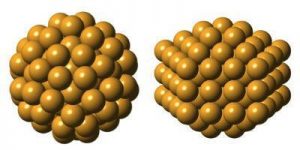What is polymorphism? In the Oxford Dictionary, polymorph is an organism or inorganic object or material that takes various forms. Polymorphism is defined, in material science, as the ability of a material to exist in more than one form of crystal structure. [Ref. 1] A recent publication from Brookhaven National Laboratories that was published in Nature Communications [Ref. 2] reports findings on Gold nanoclusters with 144 atoms. They were able to find the theoretically predicted icosahedral-cored cluster (left image below) but also found samples with truncated decahedral cores (right image). The pictures are from R&D Magazine. [Ref. 3]
The researcher, Simon Billinge and his lab, pioneered a method which they call atomic Pair Distribution Function (PDF) to analyze the results of high energy x-ray scattering from the material. The resulting polymorph provided an explanation of why other researchers have had difficulty in identifying the structure of the material. The researchers anticipate being able to find additional materials with the polymorphism.
On a different front, there is work being done on impact of environmental exposure to nanomaterials. Work being done at the Swiss Federal Laboratories for Materials Science and Technology examines an issue of the difference between materials produced for applications and those released in the environment. [Ref. 4] One example that is described is titanium dioxide. Adding the nanoparticles to paint a) enhances the self-cleaning capabilities of the paint and b) blocks UV rays thus preventing or diminishing paint degradation. One of the issues is that finding sufficient testable quantities of samples of nanoparticles that have degraded over time is difficult. This fact makes evaluations of nano-toxicity difficult if not impossible.
Work has been done [Ref. 5] on silver nanoparticles that are added to textiles as biocides to prevent the growth/spread of microorganisms. There is a release of some of the nanoparticles into the environment. However, if the released silver ions compline with other ions, like sulphides, they create silver sulphide, which is not an active biocide. This is part of an over effort to evaluate the life cycle of nanomaterials and will be available in 2017. More information is available in Reference 6.
An interesting finding is that silver nanoparticle shape affects its toxicity. [Ref. 7] Research was done on the impact of silver nanoparticles shape (spheres, rods, and plates) on rainbow trout cells and zebrafish embryos. The researchers concluded that the silver nanoplates induced oxidative stress in the cells through the production of superoxides, which are toxic. There were conditions that they placed on the experiments and will require further and expanded testing.
This brings us back to the title of this blog. If nanomaterials can have different shapes/configuration, then the potential results of toxicological investigations will depend on the shape of the material. If the material has the ability to shape-shift, how do we develop testing methodologies that account for the possible difference impact of the material shapes. If you think that the shape does not make a difference, I will give you two pounds of graphite (carbon) for one pound of diamond (carbon).
The evaluation of the environmental/human impact of any nanomaterial must incorporate the fact that these materials have properties based on the shape under test and not an overall classification of material size.
References:
- https://en.wikipedia.org/wiki/Polymorphism_(materials_science)
- http://www.nature.com/ncomms/2016/160614/ncomms11859/pdf/ncomms11859.pdf
- http://www.rdmag.com/news/2016/06/gold-nanocluster-discovery-hints-other-shape-changing-particles?et_cid=5351098&et_rid=658352741&type=headline&et_cid=5351098&et_rid=658352741&linkid=http%3a%2f%2fwww.rdmag.com%2fnews%2f2016%2f06%2fgold-nanocluster-discovery-hints-other-shape-changing-particles%3fet_cid%3d5351098%26et_rid%3d%%subscriberid%%%26type%3dheadline
- http://nanotechweb.org/cws/article/tech/65333
- http://www.ncbi.nlm.nih.gov/pubmed/24941455
- http://iopscience.iop.org/journal/0957-4484/page/Focus-Lifecycle-of-nanomaterials
- http://nanotechweb.org/cws/article/tech/49574

